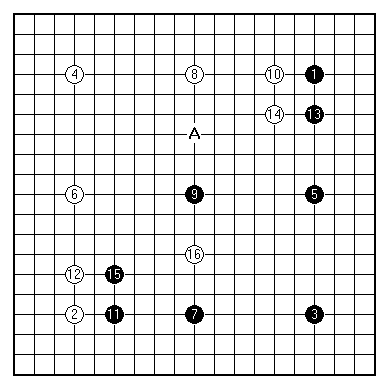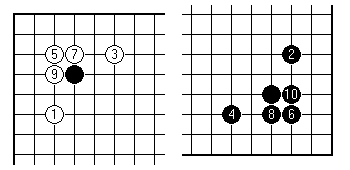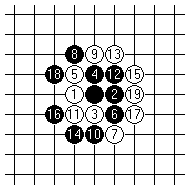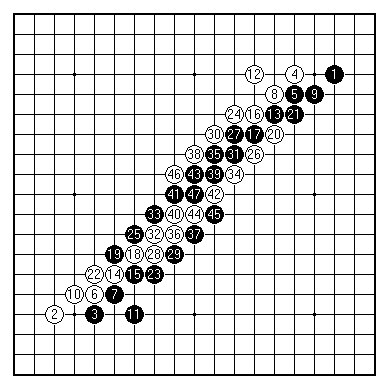

The position I was just showing you had a high degree of symmetry. This brings on a classic query:
"What if one of the players just imitates the other? I mean, each time my opponent plays, I could play in the diagonally-opposite place, relative to the centre of the board. Where does that break down as a strategy?"
Oh well, this is also a classic time-waster. But I suppose there are some lessons to be learned from it. Imitation strategy, or mirror Go (Japanese manego), comes in a number of varieties, from maniacal to sensible within limits. In no way does it undermine the depth of Go; though if the board was a grid with an even length of side, therefore having no unique central point, it becomes a bit harder to refute the idea that the second player could play symmetrically with impunity.

This is an example where mirror Go makes some sense. Black 9 occupies the centre of the board. The 10-10 point has always been considered to have a special importance; its Japanese name tengen (something like "heaven's origin") is also given to one of the top tournaments, with equivalents Tianyuan in China and Chunweon in South Korea. In the old days it was supposed that this gained Black an advantage. But in recent times, with White receiving 5.5 points komi to compensate for second play, some top pros have accepted the White side of this position, and it was played quite often a decade ago.
The continuation shown illustrates one idea: Black can now imitate White for a while. Up to 15 is reasonable enough. However when White plays 16 inside Black's large framework, it is time for a re-think. Black at A would be largely irrelevant. What is required is a play to attack the stone White has just deposited, floating on the seventh line. Black should make sure that the group White builds is kept quite weak. There is a requirement immediately to prevent it expanding towards the right-hand corner, Black's largest potential area, and quite soon Black will want to play on the left also to stop White connecting easily though the gap between 9 and 15.
Putting it another way, the play Black 9 was an investment. If White had played at A and Black had answered at 16, Black 9 would have clear value in taking central territory. When those plays are reversed, Black 9 can still shine, but only if put to work as part of an attacking plan.
There would seem to be some scope for mirror Go in handicap Go, but here again dispensing with thought is a poor idea.

It may seem amusing to twist White's tail in a handicap game by answering 1 with Black 2 in the opposite corner. However, this is a slippery slope. White 3 is arguably a better play than Black 4; with the further plays White makes tremendous gains - Black 8 and 10 are effectively worthless. By adopting this plan Black has thrown away all the advantage of the two handicap stones involved.
In different ways these examples show a natural approach to evaluating mirror strategy. Without any detailed tactical considerations, Go strategy ought to grow out of the idea of adding extra stones to make one's own existing positions look better placed, and the opponent's individual stones and groups badly positioned.

There are also specific tactical sequences that may be used to break the back of imitation plans. This is one. Here Black's occupation of the centre point ends up being a hindrance rather than a help. In some games, for example Hex, possession of a point is an unqualified plus, and one can reason on that basis that they are first-player wins. However, as this example shows, that argument doesn't hold water when applied to Go. No one doubts that there is a substantial first-player advantage in Go, and many believe that it stands at around half the value of tengen, the only "unique" play on the board. But justifying that in any serious way is a remote possibility, at best.

That deals with an imitation strategy where one player occupies the centre point early. More commonly, and seen often enough between pros, White imitates Black at the start of the game in the hope of making komi decisive, by enough devaluation of the ultimate central play. This example is a typical way to break that plan. A head-on collision of ladders is set up. White must back down early, perhaps at 14, rather than get involved in this nonsensical stuff. Incidentally, something dramatic also happens on boards of even size when ladders impinge in this way, and I leave you to find out who comes off worse.
Symmetry does play a role in Go, in specific tactical situations, and in play on the sides. In a more refined way it is subsumed in the miai concept: roughly speaking, plays A and B are miai if you are happy to get one of them and so are, without loss, able not to play either immediately. If anything is gained from this discussion in conceptualising pairs of miai as the background against which it is good to discern the unique or key point (Japanese tedomari), I'll think of it as a good evening's work.
First published 7 October 2000 as On Your Side on MindZine,
Go Learning
© Charles Matthews 2000.